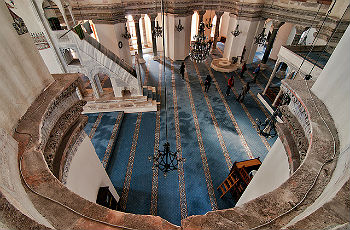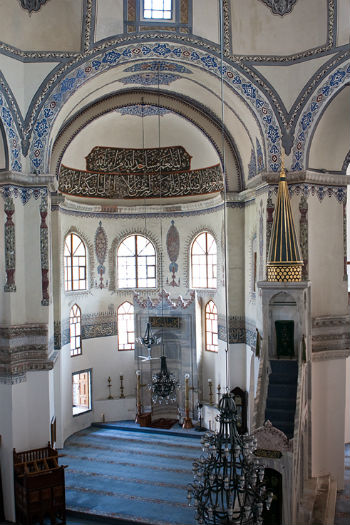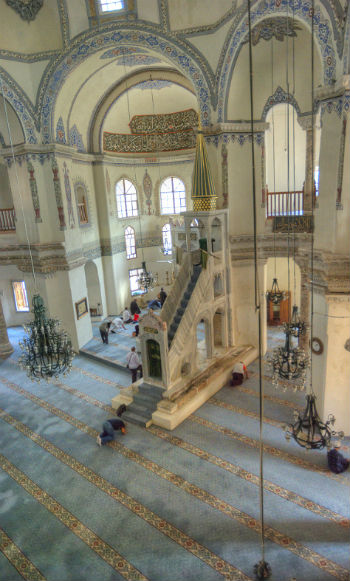Begun in 527 by Emperor Justinian, the Church of Saints Sergius and Bacchus in Istanbul was an early experiment in Byzantine architecture, with a large central dome supported by an octagonal base. The church is now a mosque called Küçük Ayasofya Camii (Little Hagia Sophia Mosque), named for its resemblance to the much larger Hagia Sophia built a few years later.
History
Saints Sergius and Bacchus are Christian Roman soldiers who were martyred in Syria in 303 AD. They became the patron saints of soldiers and their cult was very popular in Syria and beyond.
The Byzantine Emperor Justinian (r. 527-65) was among the saints’ devotees. According to legend, when Justinian was a young man he was condemned to death for plotting against Emperor Anastasius. But Sergius and Bacchus appeared to the emperor in a dream, convincing him to release Justinian.
Justinian began construction on a church dedicated to Sts Sergius and Bacchus immediately after becoming emperor himself in 527 AD; it was completed by 536 AD. The architect was Anthemius of Tralles, a mathematician and the author of a book on burning mirrors, the Paradoxographia. The chosen site was just inside the sea walls west of the Hormisdas Palace (where Justinian lived before ascending the throne), next to the Hippodrome.
The church was connected to a three-aisled basilica dedicated to St. Peter and St. Paul, which Justinian had begun to build in 519. None of it survives today. The Church of Sts. Sergius and Bacchus was built on an octagonal floor plan with a central dome, which inspired the design of the great Hagia Sophia, begun just a few years later in 532. The earlier church was therefore dubbed the Little Ayasofya.
The church was converted into a mosque in the 16th century under Sultan Beyazit II and remains an active mosque today.
What to See
Church of the Saints Sergius and Bacchus is located on the south side of Istanbul next to the Hippodrome; a railway line (near Sirkeci Station) runs between the south wall of the church and sea wall.
The Church of the Saints Sergius and Bacchus interior is decorated and furnished as a mosque, with Arabic calligraphy and designs in blue painted on white walls. Originally, the walls and vault would have been completely covered in golden mosaics, like those that survive from this period in Ravenna, and probably frescoes as well.
The architecture of the building, however, survives fully intact from the Byzantine era. So too does the Greek dedicatory inscription around the central nave:
A fine view of the interior can be had from the gallery stairs are to the right of the entrance.











Loved this little Aya Sofia! Small, simple and beautiful. We were there late in the afternoon so it was really quiet which was nice for a change. Definitely go there it is worth it!
I did not like this place at all! it was very crowded, very hot and didn't really catch my interest overall. I will not go there if I ever go back to istanbul.
This little mosque is a bit out of sultanahmet, but well worth a visit. I came upon it when I went exploring outside the busy touristy areas.
This building was constructed at the order of the Emperor Justinian in 527 as a church dedicated to Saint Sergius and Saint Bacchus. These saints were Roman soldiers who converted to Christianity and later were martyred for their faith. Justinian credited the intercession of these saints for saving his life when he was falsely accused of treason before he became…
Worth the walk down the steep streets from the Blue Mosque. It's the same age as the larger version on top of the hill, but still a functioning, living mosque. Slightly renovated and decorated but classical proportions and an spiritual ambiance missing in some of the larger mosques.
While I was here I felt a strange sense of peaceful serenity descend upon me. The place is beautiful and is lit up by natural light. There was no one else when I visited so it was all very quiet. I felt as though I had stepped back in time.
This is a fascinating building, quietly tucked away from all hustle and bustle of the main historical sites. It was late in the afternoon and it was only me in the building. A very polite man, who was obviously looking after the mosque, invited me to get inside as I was not sure whether I was allowed to.
What a beautiful, peaceful place. Our hotel was across the street from this small mosque and I could see it from my balcony. Built in the 6th century, it is beautifully preserved just inside the old city walls. In the cloister area outside is the station where worshipers wash themselves before entering the mosque and a small cemetery.
The first of the churches built by Justinian in the city, before Hagia Sophia, now a mosque. A beautiful little building with an interesting dome, deeply carved tops to the capitals, and a frieze in Greek running above them. The former medrese is now converted into little workshops for artists, with rabbits and ducks in the courtyard.
This small mosque was just as beautiful as the blue mosque but far more peaceful due to lack of tourists. The local imam was very welcoming and showed us around. Very interesting graveyard surrounding the mosque.